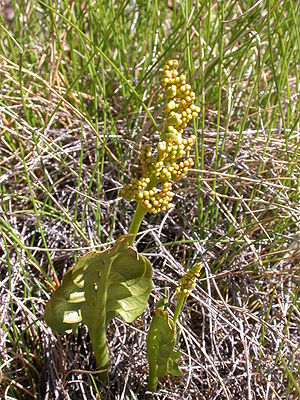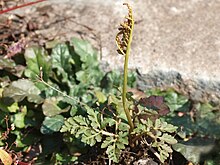Diamond ferns
| Diamond ferns | ||||||||||||
|---|---|---|---|---|---|---|---|---|---|---|---|---|

Real moon rue ( Botrychium lunaria ) |
||||||||||||
| Systematics | ||||||||||||
|
||||||||||||
| Scientific name | ||||||||||||
| Botrychium | ||||||||||||
| Sw. |
The diamond ferns ( botrychium ), often also called moon lozenges , are a genus of plants within the family of the adder tongue plants (Ophioglossaceae).
description

The diamond fern species are perennial herbaceous plants . They have weak secondary growth , which sets them apart from all other recent ferns .
The roots, which are sometimes laterally branched, are yellowish to black, have a diameter of 0.5 to 2 millimeters and are smooth or rough with cork warts.
Their leaves are divided into a sterile and a fertile part. The sterile section is flat, pinnate or two to four times pinnate. It is seldom in three parts. It is usually a bit meaty. The veins branch out in bifurcation and end freely.
The fertile part of the leaf forms a panicle of sporangia on which two rows of almost sessile, free sporangia stand. The spores are similar (isospore).
The prothallium grows underground and has a bulbous shape. It lives saprophytically on mycorrhizal fungi.
The basic chromosome number is x = 44, 45 or 92.
Locations
They grow mainly in poor, gaps in meadows and light forests.
Systematics and distribution

The genus of the diamond ferns is split into several genera depending on the author, so that in addition to botrychium in the narrower sense, the genera Sceptridium Lyon , Botrypus Rich. and Japanobotrychum Masam. stand. Smith et al. leave the genus in their fern classification to a larger extent.
Most species have a wide range of variation in their characteristics. The species numbers are given differently: 45 to 55 in the excursion flora of Austria , 50 to 60 in the flora of North America . The diamond ferns are distributed almost worldwide (sub-cosmopolitan). They have the greatest diversity in high geographical latitudes and at high altitudes. About 30 of the 45 to 60 species are native to North America.
The following species are native to Europe, many of which are endangered and partially extinct in some regions:
- Botrychium boreal mildness : It occurs in Eurasia and Greenland. in Europe it occurs in Estonia, Finland, Sweden, Norway, Russia, Iceland and on Svalbard .
- Lanceolate diamond fern ( Botrychium lanceolatum (SGGmel.) Ångstr. ): It is found in the northern hemisphere in northern Asia , North America and Greenland and in the European countries Spain , France , Italy , Switzerland , Austria , Poland , Russia , Belarus , Estonia , Latvia , Iceland , Finland , Sweden and Norway .
- Real moon rue ( Botrychium lunaria (L.) Sw. )
- Branched diamond fern ( Botrychium matricariifolium (Döll) A.Braun ex WDJKoch )
- Multi -part diamond fern ( Botrychium multifidum (SGGmel.) Rupr. )
- Simple diamond fern , simple moon rue ( Botrychium simplex E. Hitchc. )
- Virginian diamond fern , Virginian moon rue ( Botrychium virginianum (L.) Sw. ): It is common in Eurasia , North and South America.
Further species occur in North America and Asia (selection):
- Botrychium dissectum Sprengel : It occurs in northern Maritime and the Antilles.
- Botrychium japonicum (Prantl) Underwood : It occurs in Japana, Korea and China.
- Botrychium lunarioides (Michaux) Swartz : It occurs in Alabama, Arkansas, Florida, Georgia, Louisiana, Mississippi, North Carolina, South Carolina and Texas.
- Botrychium minganense Victorin : It is widespread in Alaska, Canada and the United States.
- Botrychium mormo W. H. Wagner : It occurs in Michigan, Minnesota and Wisconsin.
- Botrychium rugulosum W.H. Wagner : It occurs in eastern Canada and in the northeastern United States.
The diamond ferns are not known to be fossilized .
etymology
The genus name Botrychium is derived from the Greek botrys for grape and refers to the shape of the sporangia, which is similar to the paniculate fruiting of grapes. The German common name Mondraute indicates the belief that there is a connection between the leaf shape, especially the real moon diamond, and the phases of the moon, the second part refers to the roughly diamond-shaped outline of the leaflets.
supporting documents
- Siegmund Seybold (Ed.): Schmeil-Fitschen interactive . CD-ROM, version 1.1. Quelle & Meyer, Wiebelsheim 2002, ISBN 3-494-01327-6 .
- Warren H. Wagner Jr., Florence S. Wagner: Botrychium. In: Flora of North America Editorial Committee (Ed.): Flora of North America North of Mexico . Volume 2: Pteridophytes and Gymnosperms . Oxford University Press, New York / Oxford a. a. 1993, ISBN 0-19-508242-7 , pp. 86–101 (English, limited preview in Google Book Search). , online (English).
Individual evidence
- ^ Alan R. Smith, Kathleen M. Pryer, Eric Schuettpelz, Petra Korall, Harald Schneider, Paul G. Wolf: A classification for extant ferns. In: Taxon. Volume 55, No. 3, 2006, ISSN 0040-0262 , pp. 705–731, abstract, ( Memento of the original dated February 12, 2017 in the Internet Archive ) Info: The archive link was inserted automatically and has not yet been checked. Please check the original and archive link according to the instructions and then remove this notice. PDF file .
- ^ Manfred A. Fischer, Wolfgang Adler, Karl Oswald: Excursion flora for Austria, Liechtenstein and South Tyrol . 2nd, improved and enlarged edition. State of Upper Austria, Biology Center of the Upper Austrian State Museums, Linz 2005, ISBN 3-85474-140-5 .
- ↑ a b c d e f Warren H. Wagner Jr., Florence S. Wagner: Botrychiums Swartz. In: Flora of North America, vol. 2. [1] .
- ↑ a b M. Christenhusz, E. von Raab-Straube (2013): Lycopodiophytina. : Datasheet Botrychium In: Euro + Med Plantbase - the information resource for Euro-Mediterranean plant diversity.
- ↑ Botrychium in the Germplasm Resources Information Network (GRIN), USDA , ARS , National Genetic Resources Program. National Germplasm Resources Laboratory, Beltsville, Maryland. Retrieved July 17, 2016.
- ↑ Zhang Xianchun & Norio Sahashi: Botrychium Linnaeus. - Same text online as the printed work , In: Wu Zheng-yi, Peter H. Raven, Deyuan Hong (Ed.): Flora of China. Volume 2-3: Ophioglossaaceae. Science Press and Missouri Botanical Garden Press, Beijing and St. Louis 2010

